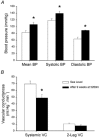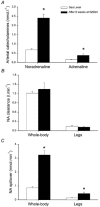Chronic hypoxia increases blood pressure and noradrenaline spillover in healthy humans
- PMID: 12844510
- PMCID: PMC2343162
- DOI: 10.1113/jphysiol.2003.045112
Chronic hypoxia increases blood pressure and noradrenaline spillover in healthy humans
Abstract
Chronic hypoxia is associated with elevated sympathetic activity and hypertension in patients with chronic pulmonary obstructive disease. However, the effect of chronic hypoxia on systemic and regional sympathetic activity in healthy humans remains unknown. To determine if chronic hypoxia in healthy humans is associated with hyperactivity of the sympathetic system, we measured intra-arterial blood pressure, arterial blood gases, systemic and skeletal muscle noradrenaline (norepinephrine) spillover and vascular conductances in nine Danish lowlanders at sea level and after 9 weeks of exposure at 5260 m. Mean blood pressure was 28 % higher at altitude (P < 0.01) due to increases in both systolic (18 % higher, P < 0.05) and diastolic (41 % higher, P < 0.001) blood pressures. Cardiac output and leg blood flow were not altered by chronic hypoxia, but systemic vascular conductance was reduced by 30 % (P < 0.05). Plasma arterial noradrenaline (NA) and adrenaline concentrations were 3.7- and 2.4-fold higher at altitude, respectively (P < 0.05). The elevation of plasma arterial NA concentration was caused by a 3.8-fold higher whole-body NA release (P < 0.001) since whole-body noradrenaline clearance was similar in both conditions. Leg NA spillover was increased similarly (x 3.2, P < 0.05). These changes occurred despite the fact that systemic O2 delivery was greater after altitude acclimatisation than at sea level, due to 37 % higher blood haemoglobin concentration. In summary, this study shows that chronic hypoxia causes marked activation of the sympathetic nervous system in healthy humans and increased systemic arterial pressure, despite normalisation of the arterial O2 content with acclimatisation.
Figures


References
-
- Alexander JK, Grover RF. Mechanism of reduced cardiac stroke volume at high altitude. Clin Cardiol. 1983;6:301–303. - PubMed
-
- Antezana AM, Kacimi R, Le Trong JL, Marchal M, Abousahl I, Dubray C, Richalet JP. Adrenergic status of humans during prolonged exposure to the altitude of 6,542 m. J Appl Physiol. 1994;76:1055–1059. - PubMed
-
- Azevedo ER, Newton GE, Floras JS, Parker JD. Reducing cardiac filling pressure lowers norepinephrine spillover in patients with chronic heart failure. Circulation. 2000;101:2053–2059. - PubMed
Publication types
MeSH terms
Substances
LinkOut - more resources
Full Text Sources
Other Literature Sources

